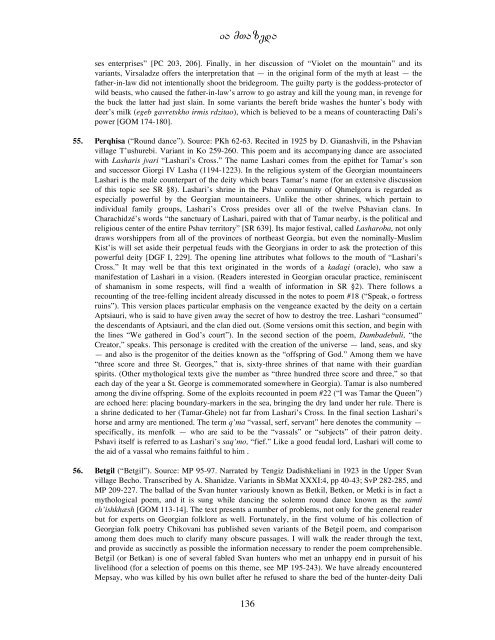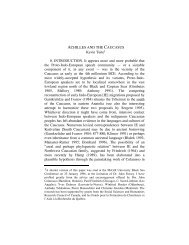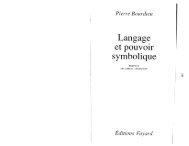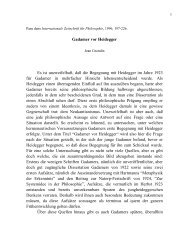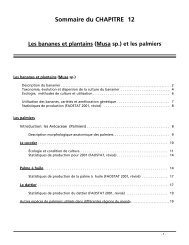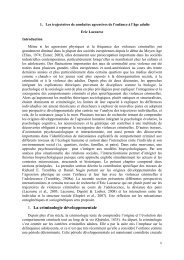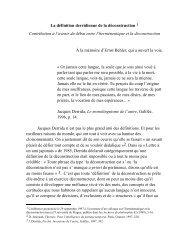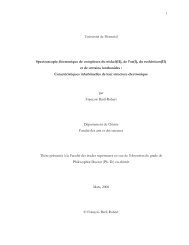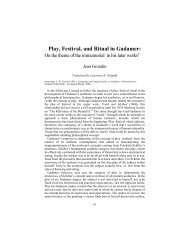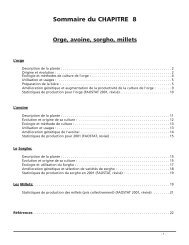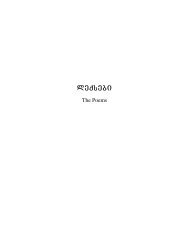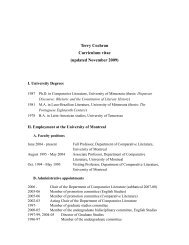Create successful ePaper yourself
Turn your PDF publications into a flip-book with our unique Google optimized e-Paper software.
ia mtazeda<br />
ses enterprises” [PC 203, 206]. Finally, in her discussion of “Violet on the mountain” and its<br />
variants, Virsaladze offers the interpretation that — in the original form of the myth at least — the<br />
father-in-law did not intentionally shoot the bridegroom. The guilty party is the goddess-protector of<br />
wild beasts, who caused the father-in-law’s arrow to go astray and kill the young man, in revenge for<br />
the buck the latter had just slain. In some variants the bereft bride washes the hunter’s body with<br />
deer’s milk (egeb gavretskho irmis rdzitao), which is believed to be a means of counteracting Dali’s<br />
power [GOM 174-180].<br />
55. Perqhisa (“Round dance”). Source: PKh 62-63. Recited in 1925 by D. Gianashvili, in the Pshavian<br />
village T’ushurebi. Variant in Ko 259-260. This poem and its accompanying dance are associated<br />
with Lasharis jvari “Lashari’s Cross.” The name Lashari comes from the epithet for Tamar’s son<br />
and successor Giorgi IV Lasha (1194-1223). In the religious system of the Georgian mountaineers<br />
Lashari is the male counterpart of the deity which bears Tamar’s name (for an extensive discussion<br />
of this topic see SR §8). Lashari’s shrine in the Pshav community of Qhmelgora is regarded as<br />
especially powerful by the Georgian mountaineers. Unlike the other shrines, which pertain to<br />
individual family groups, Lashari’s Cross presides over all of the twelve Pshavian clans. In<br />
Charachidzé’s words “the sanctuary of Lashari, paired with that of Tamar nearby, is the political and<br />
religious center of the entire Pshav territory” [SR 639]. Its major festival, called Lasharoba, not only<br />
draws worshippers from all of the provinces of northeast Georgia, but even the nominally-Muslim<br />
Kist’is will set aside their perpetual feuds with the Georgians in order to ask the protection of this<br />
powerful deity [DGF I, 229]. The opening line attributes what follows to the mouth of “Lashari’s<br />
Cross.” It may well be that this text originated in the words of a kadagi (oracle), who saw a<br />
manifestation of Lashari in a vision. (Readers interested in Georgian oracular practice, reminiscent<br />
of shamanism in some respects, will find a wealth of information in SR §2). There follows a<br />
recounting of the tree-felling incident already discussed in the notes to poem #18 (“Speak, o fortress<br />
ruins”). This version places particular emphasis on the vengeance exacted by the deity on a certain<br />
Aptsiauri, who is said to have given away the secret of how to destroy the tree. Lashari “consumed”<br />
the descendants of Aptsiauri, and the clan died out. (Some versions omit this section, and begin with<br />
the lines “We gathered in God’s court”). In the second section of the poem, Dambadebuli, “the<br />
Creator,” speaks. This personage is credited with the creation of the universe — land, seas, and sky<br />
— and also is the progenitor of the deities known as the “offspring of God.” Among them we have<br />
“three score and three St. Georges,” that is, sixty-three shrines of that name with their guardian<br />
spirits. (Other mythological texts give the number as “three hundred three score and three,” so that<br />
each day of the year a St. George is commemorated somewhere in Georgia). Tamar is also numbered<br />
among the divine offspring. Some of the exploits recounted in poem #22 (“I was Tamar the Queen”)<br />
are echoed here: placing boundary-markers in the sea, bringing the dry land under her rule. There is<br />
a shrine dedicated to her (Tamar-Ghele) not far from Lashari’s Cross. In the final section Lashari’s<br />
horse and army are mentioned. The term q’ma “vassal, serf, servant” here denotes the community —<br />
specifically, its menfolk — who are said to be the “vassals” or “subjects” of their patron deity.<br />
Pshavi itself is referred to as Lashari’s saq’mo, “fief.” Like a good feudal lord, Lashari will come to<br />
the aid of a vassal who remains faithful to him .<br />
56. Betgil (“Betgil”). Source: MP 95-97. Narrated by Tengiz Dadishkeliani in 1923 in the Upper Svan<br />
village Becho. Transcribed by A. Shanidze. Variants in SbMat XXXI:4, pp 40-43; SvP 282-285, and<br />
MP 209-227. The ballad of the Svan hunter variously known as Betkil, Betken, or Metki is in fact a<br />
mythological poem, and it is sung while dancing the solemn round dance known as the samti<br />
ch’ishkhæsh [GOM 113-14]. The text presents a number of problems, not only for the general reader<br />
but for experts on Georgian folklore as well. Fortunately, in the first volume of his collection of<br />
Georgian folk poetry Chikovani has published seven variants of the Betgil poem, and comparison<br />
among them does much to clarify many obscure passages. I will walk the reader through the text,<br />
and provide as succinctly as possible the information necessary to render the poem comprehensible.<br />
Betgil (or Betkan) is one of several fabled Svan hunters who met an unhappy end in pursuit of his<br />
livelihood (for a selection of poems on this theme, see MP 195-243). We have already encountered<br />
Mepsay, who was killed by his own bullet after he refused to share the bed of the hunter-deity Dali<br />
136


